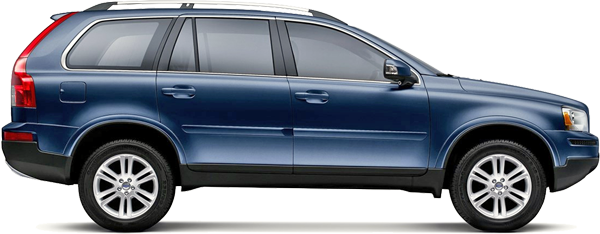The Comparative Analysis :
Audi e-tron Sportback 50 quattro (20 - ..) vs. Volvo XC90 D3 Geartronic (7-seater) (10 - 11)
€ 71,400

€ 40,000

€ 71,400
Base Price ⓘBase price of a new vehicle with standard equipment in Germany at market launch.
€ 40,000
ⓘBase price of a new vehicle with standard equipment in Germany at market launch. Price Info
Vehicle Dimensions
The dimensions of these vehicles differ considerably. The Audi e-tron Sportback 50 is 9.4 cm longer, 3.7 cm wider and 16.8 cm lower than the Volvo XC90 D3.
Audi e-tron Sportback 50
Volvo XC90 D3
1616
1935
2043
1784
1898
2110
1935 mm
Width
1898 mm
2043 mm
Width Incl. Mirrors
2110 mm
1616 mm
Height
1784 mm
2928
4901
2857
4807
4901 mm
Length
4807 mm
2928 mm
Wheelbase
2857 mm
Vehicle Weight
Audi e-tron Sportback 50
Volvo XC90 D3
2445 kg
Kerb Weight
2127 kg
3040 kg
Gross Vehicle
Weight
Weight
2680 kg

Weight Difference:
318 kg
13.01 %

General
Audi e-tron Sportback 50
Volvo XC90 D3
GE
Generation
C
Sport Utility Vehicle
Car Body Style
Sport Utility Vehicle
Electricity
Fuel Type
Diesel

Permanent all-wheel drive
Drive
Front-wheel drive

1-speed automatic transmission
Transmission
6-speed automatic transmission
Engine
Audi e-tron Sportback 50
Volvo XC90 D3
Asynchronous motor
Engine Type
Straight-five diesel engine with turbocharger
Engine Code
D5244T5
0
Valves
4
0
Cylinders
5
0 CC
Engine Capacity
2400 CC
309 bhp
at 0 rpm
Power
161 bhp
at 4000 rpm
Audi e-tron Sportback 50
309 bhp
161 bhp
Volvo XC90 D3
540 NM
at 0 rpm
Max. Torque
340 NM
at 1750 rpm
Audi e-tron Sportback 50
540 NM
340 NM
Volvo XC90 D3
Performance
Audi e-tron Sportback 50
Volvo XC90 D3
118 mph
Maximum Speed
118 mph
6.8 sec
Acceleration 0 to 62 mph
11.8 sec
62 mph
62
mph
mph
94 m
0.000 sec

Audi e-tron Sportback 50
62 mph
62
mph
mph
164 m
0.000 sec

Volvo XC90 D3
▶ REPLAY
7.91 kg/bhp
Weight-to-Power Ratio
13.21 kg/bhp
Audi e-tron Sportback 50
7.91 kg/bhp
13.21 kg/bhp
Volvo XC90 D3
Fuel Economy / Emissions
Audi e-tron Sportback 50
Volvo XC90 D3
Fuel Economy
34 kWh✽
( 116 MPGe ⓘ Miles per gallon petrol equivalent (MPGe) is a measure of the average distance traveled per unit of energy consumed. MPGe, specified in miles per imperial gallon (~4.546 litres), is used to compare the energy consumption of vehicles that use different energy sources.)
combined ✽ per 100 miles
34 mpg
( 39 MPGe ⓘ Miles per gallon petrol equivalent (MPGe) is a measure of the average distance traveled per unit of energy consumed. MPGe, specified in miles per imperial gallon (~4.546 litres), is used to compare the energy consumption of vehicles that use different energy sources.)
Audi e-tron Sportback 50
116 MPGe
39 MPGe
Volvo XC90 D3
No data
city
26 mpg
No data
motorway
42 mpg
65 kWh
Fuel Tank Capacity
68 L
189 mi
Range
515 mi
Audi e-tron Sportback 50
189 mi
515 mi
Volvo XC90 D3
Environmental Impact
69.5 kWh
Total Energy Consumption
per 100 miles ⓘThe total energy consumption per 100 miles is the amount of energy consumed by a vehicle when burning fuel or using electricity per 100 miles (final energy), and the energy required to produce the appropriate amount of fuel or electricity (primary energy).
per 100 miles ⓘThe total energy consumption per 100 miles is the amount of energy consumed by a vehicle when burning fuel or using electricity per 100 miles (final energy), and the energy required to produce the appropriate amount of fuel or electricity (primary energy).
168.7 kWh
Audi e-tron Sportback 50
69.5 kWh
168.7 kWh
Volvo XC90 D3
Elektrofahrzeug
Emission Standard
Euro 5
0 g/km (WLTP)
CO2 Emissions
216 g/km (NEFZ)
Practical Convenience
Audi e-tron Sportback 50
Volvo XC90 D3
5
Doors
5
5
No. of Seats
7
595 kg
Maximum Payload
553 kg
615 L
Boot Capacity
249 L











1655 L
Boot Capacity (Seats Down)
1837 L





















